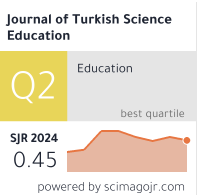Adoptinge educational robotics to enhance undergraduate students’ self-efficacy levels of computational thinking
DOI:
https://doi.org/10.36681/Keywords:
Computational Thinking Skill, educational robotics, self-efficafy, STEM LearningAbstract
Computational Thinking (CT) skill, as an essential 21st-century skill, is an important problem-solving and survival abilities in the era of disruption. Universal principles generating a pattern of abstraction develop step-by-step troubleshooting instructions in solving similar problems, perceiving similarities/differences between the patterns, and making a complex problem solvable. The skill could be applied to various engineering fields by emphasising efficiency, accuracy, and capability of problem-solving. Recently, robot enthusiasts in Science, Technology, Engineering and Math (STEM) learning that involves ‘assembling, programming and testing’ activities, underscore CT skills. This research explores the CT pattern along with participants-developed robotics activities.
Downloads
References
Ackermann, E. (2001). Piaget’s constructivism, Papert’s constructionism: What’s the difference. Future of learning group publication, 5(3), 1-11.
Alimisis, D., Arlegui, J., Fava, N., Frangou, S., Ionita, S., Menegatti, E., ... Pina, A. (2010). Introducing robotics to teachers and schools: experiences from the TERECoP project. Proceedings for Constructionism, 1, 1-10.
Alimisis, D. (2012). Robotics in education & education in robotics: Shifting focus from technology to pedagogy. In Proceedings of the 3rd International Conference on Robotics in Education, 7-14.
Alimisis, D., Moro, M., Arlegui, J., Pina, A., Frangou, S., & Papanikolaou, K. (2007, August). Robotics & constructivism in education: The TERECoP project. In EuroLogo 40, 19-24.
Atmatzidou, S., & Demetriadis, S. (2014). How to Support Students’ Computational Thinking Skills in Educational Robotics Activities. Paper presented at the Proceedings of 4th International Workshop Teaching Robotics, Teaching with Robotics & 5th International Conference Robotics in Education, Padova, Italy.
Atmatzidou, S., & Demetriadis, S. (2016). Advancing students’ computational thinking skills through educational robotics: A study on age and gender relevant differences. Robotics and Autonomous Systems, 75, 661-670.
Bers, M. U., Flannery, L., Kazakoff, E. R., & Sullivan, A. (2014). Computational thinking and tinkering: Exploration of an early childhood robotics curriculum. Computers & Education, 72, 145-157.
Bocconi, S., Chioccariello, A., Dettori, G., Ferrari, A., Engelhardt, K., Kampylis, P., & Punie, Y. (2016). Developing computational thinking in compulsory education. European Commission, JRC Science for Policy Report.
Brennan, K., & Resnick, M. (2012, April). New frameworks for studying and assessing the development of computational thinking. In Proceedings of the 2012 annual meeting of the American Educational Research Association, Vancouver, Canada, 1-25.
Catlin, D., & Woollard, J. (2014, July). Educational robots and computational thinking. In Proceedings of 4th International Workshop Teaching Robotics, Teaching with Robotics & 5th International Conference Robotics in Education, 144-151.
Cresswell, J. W. (2014). Penelitian kualitatif & desain riset. Yogyakarta: Pustaka Pelajar.
Eguchi, A. (2014, July). Robotics as a learning tool for educational transformation. In Proceeding of 4th International Workshop Teaching Robotics, Teaching with Robotics & 5th International Conference Robotics in Education Padova (Italy).
Kamal, F., Budiyanto, C. W., & Efendi, A. (2018, November). Understanding students behavior during the adoption of modular robotics in learning. In IOP Conference Series: Materials Science and Engineering, 434(1), p. 012263. IOP Publishing.
Karim, M. E., Lemaignan, S., & Mondada, F. (2015). A review: Can robots reshape K-12 STEM education?. In Advanced Robotics and its Social Impacts (ARSO), 2015 IEEE International Workshop on,1-8. IEEE.
Kazimoglu, C., Kiernan, M., Bacon, L., & Mackinnon, L. (2012). A serious game for developing computational thinking and learning introductory computer programming. Procedia-Social and Behavioural Sciences, 47, 1991-1999.
Miglino, O., Lund, H. H., & Cardaci, M. (1999). Robotics as an educational tool. Journal of Interactive Learning Research, 10(1), 25.
Miles, M. B., Huberman, A. M., & Saldana, J. (1984). Qualitative Data Analysis: A Methods Sourcebook. Sage Publications Ltd (CA).
Papert, S. (1980). Mindstorms: Children, computers, and powerful ideas. New York: Basic Books, Inc.
Weese, J. L., & Feldhausen, R. (2017). STEM Outreach: Assessing Computational Thinking and Problem Solving. Paper presented at the 2017 ASEE Annual Conference & Exposition.
Wing, J. M. (2006). Computational thinking. Communications of the ACM, 49(3), 33-35.
Wing, J. M. (2008). Computational thinking and thinking about computing. Philosophical Transactions of the royal society of London A: mathematical, physical and engineering sciences, 366(1881), 3717-3725.
Published
Versions
- 15.12.2018 (2)
- 15.12.2018 (1)
Issue
Section
License

This work is licensed under a Creative Commons Attribution-NonCommercial-NoDerivatives 4.0 International License.
This license enables reusers to copy and distribute the material in any medium or format in unadapted form only, for noncommercial purposes only, and only so long as attribution is given to the creator. CC BY-NC-ND includes the following elements: Credit must be given to the creator; only noncommercial uses of the work are permitted; no derivatives or adaptations of the work are permitted.



